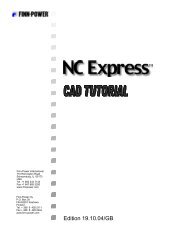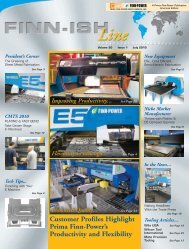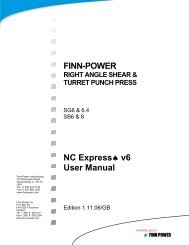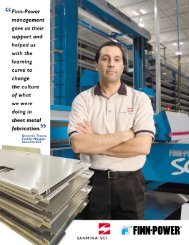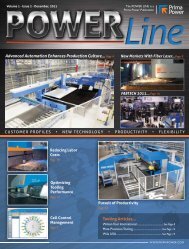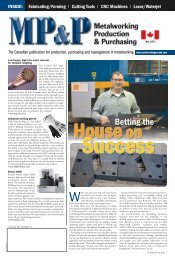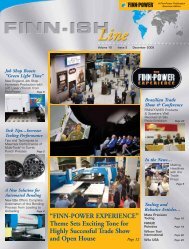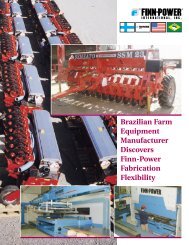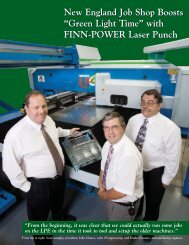Stand-Alone Punch machine user manual - Finn-Power International ...
Stand-Alone Punch machine user manual - Finn-Power International ...
Stand-Alone Punch machine user manual - Finn-Power International ...
Create successful ePaper yourself
Turn your PDF publications into a flip-book with our unique Google optimized e-Paper software.
In general, when utilizing Common Line the nest engine decides which parts will be<br />
common lined. The next section will demonstrate how to utilize common line<br />
within NC Express.<br />
5.7.3 Exercise 2- Common line Nesting<br />
Parts that share the same symmetry are capable of automatically being nested.<br />
Below will demonstrate how to do this.<br />
Before starting this exercise there are two parts that will need to be created. When<br />
setting up the parts use the same material type and thickness.<br />
Step 1: Create a new part. Enable common line within the part properties.<br />
Disable nest rotations for the parts.<br />
Step 2: Import NESTPART1.dxf and save.<br />
Step 3: Autotool the part using only punch tooling around the outside. Set the<br />
parts to be externally microjointed in the four corners. Make sure there are no<br />
microjoints anywhere else but the corners. All tooling will need to match on<br />
each side of the part (symmetry).<br />
Step 4: Save part.<br />
Step 5: Repeat steps 1-4 for NESTPART2.dxf<br />
Once parts are created they are ready to be common line nested. The following<br />
is the process of creating a common line nest automatically.<br />
Step 1: Create a new nest by going to File menu | New – Nest, enter run<br />
number 110 and also select the same material type and thickness used to create<br />
the two parts- NESTPART1.cp and NESTPART2.cp.<br />
Step 2: Go to the Part List and schedule both of the common line parts to be<br />
nested. For NESTPART1.cp enter a quantity of 28 and for NESTPART2.cp<br />
enter a quantity of 10.<br />
Step 3: Utilize a plate size of 100”x50” (2500mmx1250mm) to nest the parts.<br />
Step 4: Global parameters.<br />
a. Enter part separation equal of tooling that was used on the outside<br />
of the parts. (Ex. 0.25”x3.00” tool used on the top and bottom Y-<br />
0.25” & 0.125”x1.50” tool used on sides X- 0.125”)<br />
b. Set Nest Direction to- Top left<br />
c. Enable Common line- Same part only<br />
Note- Notice that when common line is activated in the nest dialog some<br />
options are unavailable. This is because the nest environment has now changed<br />
to grid nesting only. Parts are nested symmetrically, and if parts are not<br />
symmetrical they are nested in a grid pattern.<br />
Step 5: Click OK to nest parts.<br />
5-93




